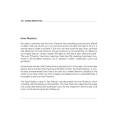Dhamma Hall : ค้นหาหนังสือธรรมะ
หน้าหนังสือทั้งหมด

23
WORLD DHAMMAKAYA CENTRE
WORLD DHAMMAKAYA CENTRE
O n its present 800 acres site, WDC will comprise the Great Sapha Dhammakaya Assembly Hall (the largest spiritual assembly hall in the world), the Phramonkollthepmuni Vihara,
The World Dhammakaya Centre spans 800 acres and includes the Great Sapha Dhammakaya Assembly Hall, the largest spiritual hall globally, and the Phramonkollthepmuni Vihara, dedicated to the revered med

52
Evolution of Meditation Halls in Dhamma Practice
The very first meditation hall, accommodating only 500 people (named ‘Catummaharajika’), was filled to its capacity in only 5 years. The number of people who attended the sermon grew at a very fast pa
The first meditation hall named 'Catummaharajika' quickly filled to capacity within five years. As attendance grew, even outdoor seating became necessary during ceremonies led by Luang Phaw Dhammajayo

50
Understanding the Connotation of Dhamma in Relation to Brahma
In the case that ‘brahma-’ refers to the masculine ‘Brahma’
In case of the term ‘brahma-’ in the three compounds50 being
translated as a masculine ‘Brahma,’51 the comparison of the first and
the third
In this text, the term 'brahma-' is analyzed in the context of its translation as the masculine 'Brahma.' It discusses how the comparison between the Tathāgata and the Brahma, the creator, illustrates

54
Understanding Dhamma and Brahman in Buddhism
In the case that 'brahma-' refers to the neuter 'brahman'
In the other case in which the term brahma- is translated as 'brahman'63 the ultimate,64 the third parallel65 suggests that the term dhamma in
This text clarifies that the term 'brahma-' can refer to either the masculine 'Brahmā' or the neuter 'brahman,' ultimately leading to the view that dhamma signifies transcendental realities. It sugges

72
The Path to Right View and World Peace
Nic Mush-wi. A Dhamma Master
must have the right view in order to start, and to understand, how to bring about world peace. We know, of course, that we are all made of body, mind, and Dhamma, and wit
This text emphasizes the significance of the right view in attaining world peace, stating that Dhamma must be understood and implemented in one’s life. The essence of meditation tied to the eightfold

65
Dhammakaya Temple: A Community of Peace and Meditation
The Dhammakaya Temple is more than just temple buildings. It is a community that exemplifies a culture of peace and non-violence where meditation comes first and material concerns come last.
Establis
The Dhammakaya Temple, established on February 20, 1970, embodies a culture of peace and meditation, prioritizing spiritual growth over material concerns. It features the largest meditation hall, capa

40
Understanding Dhammakāya in Aṅgāṇā-sutta
In brief, contemporary academics refer to the term dhammakāya in the Aṅgāṇā-sutta either as a noun or an adjective. As a noun, the term is interpreted mostly as the Buddha’s teachings collected togeth
The term dhammakāya is interpreted in contemporary academia as both a noun and an adjective. As a noun, it denotes the Buddha’s teachings, while as an adjective, it refers to the nature of the Tathāga

48
Brahmins and Noble Disciples: A Comparative Analysis
No. | Brahmins (D.III.81) | Noble Disciples (D.III.84) | Implied Parallel
---|------------------------|---------------------------|------------------------
1. | Brahma's children | Tathägata's sons |
The text presents a comparative analysis between Brahmins and Noble Disciples, highlighting their similarities in mythical and spiritual parental origins. It details how both are seen as offsprings of

41
Understanding Dhammakāya: A Scholarly Interpretation
Points to Consider
It may be observed that the difference in previous scholarly interpretations of the term dhammakāya in this passage mainly pertains to the inter-relatedness of two distinctive meani
This text delves into scholarly interpretations of the term 'dhammakāya', emphasizing the need for a nuanced understanding of 'dhamma' as both a realized reality and a verbal expression. It identifies

58
Understanding the Concept of Body and Collection in Dhamma
Functionally, however, both terms seem to imply a different relationship between individual members and the ‘totality’ of the whole ‘body’ or ‘collection.’ As a ‘body,’ the ‘totality’ of the whole org
This text analyzes the distinctions between the terms 'body' and 'collection' within the framework of Dhamma, particularly focusing on functional dependence. It argues that while a 'body' maintains es

81
Understanding Dhammikāya in Buddhist Philosophy
Dhammapāla, like Buddhaghosa, employs the term dhammikāya
mostly as a noun, and relates it either with the Buddha’s mental
qualities and purity,134 with the Enlightenment either of the Buddha135
or hi
Dhammapāla discusses dhammikāya, relating it to the Buddha's mental qualities and Enlightenment. This term connects the Buddha's teachings and truths, illustrating his purity and extraordinary qualiti

108
Understanding Defilements and Dhamma in Buddhism
Meticulous with a Dharma Messenger
If we are not mindful, then defilements become even more apparent to us. We must bring together concentration, effort, and meditation. They must all come together.
This text delves into the importance of mindfulness to combat defilements and achieve purity through meditation. It emphasizes the synergy of concentration, effort, and mindfulness. The Buddha's journ

53
Understanding Dhamma and Nibbāna in Buddhism
With regard to dhamma as the 'essence' of the Buddha and Arhat disciples, however, it may be more appropriate to refer to 'Nibbāna,' for once they have attained Buddhahood and Arhatship their spiritua
This text explores the concept of dhamma in relation to the Buddha and Arhat disciples, particularly the notion of Nibbāna as the essence of their enlightenment. It argues that dhamma, especially in t

61
Exploring the Concept of Dhammakaya
First, as a *kammadhāra* compound, the translation of the term *dhammākāya* will be ‘the body that is transcendental (lokuttara) dhamma’ or ‘the body that is Nibbāna.’ This gives a similar sense as th
The term Dhammakaya can be viewed in two ways: as a kammadhāra compound translated to mean 'the body that is transcendental dhamma' or as a tappurisa compound meaning 'body pertaining to transcendenta

112
Understanding Inner Dhamma
Inner Dhamma
We used to perceive that the inner Dhamma was something profound and difficult to attain, that one had to put in an immense amount of effort and had to do it in a remote place in order to
Inner Dhamma was once seen as a profound, difficult achievement requiring immense effort in isolation. However, it is now understood that maintaining an alert, relaxed, and still mind allows access to

40
Meetings with a Dhamma Master: Insights from Luang Por
Meetings with a Dhamma Master
Meeting #5
March 5, 2009 – Panawat Retreat Center
Right before the Peace Revolution Conference ended, several of the participants and I decided to attend another retrea
In this reflective account, the author shares insights from a meeting with Luang Por at Panawat Retreat Center, discussing the duality of body and mind. The narrative takes place in a picturesque medi

187
The Sacred Formulas of Luang Phaw Wat Paknam
For example, if there were statements about constructing a
Dhamma Hall or a monk's shelter soon, then this must happen.
In short, the temple must produce results as soon …
The teachings of Luang Phaw Wat Paknam emphasize three sacred formulas essential for temple prosperity: cleanliness, diligent teaching of Dhamma, and frequent meditation practice. Cleanliness is vital

49
มหาวิหารของคุณยายอาจารย์และอุโบสถ
The Memorial Hall of Khun Yay Ajahn (มหาวิหารของคุณยายอาจารย์), a place that enshrines Khun Yay’s relics and golden statute. Inside the Hall is a jade room. Capacity: 300 people.
The Main Chapel (อุโ
มหาวิหารของคุณยายอาจารย์เป็นสถานที่เก็บรักษาเศษส่วนและรูปปั้นทองคำของคุณยาย ภายในมีห้องหยก รองรับผู้เข้าชมได้ 300 คน อุโบสถเป็นสถานที่บวชของพระและสามเณรจากทุกชาติพันธุ์ ห้องหอฉันคุณยายอาจารย์เป็นห้องอ

43
Receiving Guests with Compassion and Dhamma
40. RECEIVING GUESTS
Receiving guests who inquire for your help is not easy. We must learn the proper way to do it. Although we must cater to them, we must also maintain our moral nature, especially
Receiving guests seeking guidance can be challenging. It is essential to cater to them while upholding our moral nature and Dhamma. Guests often share their struggles, which can distract us from our p

23
Understanding Dhamma and its Significance
Dhamma; Dharma; the truth; the natural condition of things or beings; the law of their existence; the ethical code of righteousness; the whole body of religious doctrines as a system; the Teachings of
Dhamma, central to Buddhist philosophy, refers to the natural condition of existence and the ethical framework guiding moral conduct. It embodies the teachings of the Buddha, manifesting truths realiz
